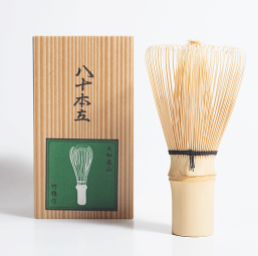|
On Wednesday March 14th the Tea Guild of Canada had a St Patrick’s Day with Matcha event. The presenters were Momo Yoshida of Momo Tea and Sorlie Madox and Helen Kong of Secret Teatime.
After attendees mingled over refreshments (including organic tofu and vegetable green rice makis), the program started with a Sencha tea (Japanese steamed green tea) being served and a brief presentation of matcha agriculture and it’s production process. This was followed by Momo demonstrating a tray-tea Chado service tea ceremony on a tatami mat (on the floor) while Sorlie and Helen spoke about this versatile and ritual way of making matcha. The meaning of Chado is Cha = tea and Do = path or road. Which translates as “The Way of Tea”. To master Chado, or The Way of Tea, is a lifetime of learning. There are different schools of tea. There are three historical households descended from the 16th-century tea master Sen no Rikyū. These three schools of tea are the Omotesenke, Urasenke, and Mushakōji. According to Sorlie, some Merchant schools of tea (like the ones that are practiced by the descendants of Rikyu) are slower and flashier than contemporary forms practiced by Samurai tea schools. We learned that in the spring a new tea of that year (usually tencha leaves which are used for making matcha) are placed into an urn and sealed and buried for the summer months to age. In the autumn the urn is opened in an important ritual marking a tea person’s New Year, or the Kuchi-kiri (opening of the tea urn). There is then a ceremony for the grinding of these tencha leaves into matcha. Gyokuro is like a sister to Matcha, as both of them are shaded for at least 20 days. This shuts out the direct sunlight to reduce the rate of photosynthesis resulting in high levels of theanine, the amino acid responsible for the full-bodied flavor of the matcha and gyokuro teas. There are two types of matcha preparation: Koicha and Usucha. Koicha is a very thick tea and looks like glossy paint. Historically it was considered medicinal and was also referred to as having a “dose” of tea. Usacha is a thin tea which whisks up into a foam on top. Momo pointed out something to be wary of. Make sure what you purchase is actually matcha and not ‘green tea powder’. Green tea powder is ground Sencha and is very bitter and not very nice tasting. Matcha is ground tencha leaves and is most flavourful and pleasing. Sencha, although an excellent tea when prepared correctly, is not a shaded tea and is not pleasant in a ground form
Shapes of Chawan:
Chasen Care:
3. Cleaning the tools
4. Preparing the matcha 5. Serving the matcha to guests 6. Completing the ceremony, cleaning of utensils (The guests need to inspect the tools used in the ceremony as a sign of respect and admiration for the host) How to drink the Matcha from the bowl during the ceremony: 1.Pick up your tea bowl using your right hand 2.Place the tea bowl on the palm of your left hand, and rotate it twice clockwise 3. Drink (with 3-4 sips, or 10 depending on the school). Make an audible slurp on the last sip 4. When you’re finished drinking, rotate the tea bowl twice counter-clockwise before placing it back in the original location 5. Admire the bowl People were encouraged to bring their own Chawans (tea bowls) and Chasens (bamboo whisks) and we had plenty on hand as well. There was quite an array of beautiful ceramic tea ware to behold! Participants had the opportunity for a hands-on experience of whisking and drinking matcha while being served wonderful matcha macaroons, coconut macaroons, and huge delicious organic daifuku (glutinous rice sweets filled with naturally flavoured and sweetened bean paste). There were two types of daifuku: Matcha and Yuzu (a Japanese citrus fruit). The word Daifuku translates as ‘Great Luck’ which was fitting for this St Patrick’s Day event! |
AuthorWrite something about yourself. No need to be fancy, just an overview. Archives
March 2018
Categories |







 RSS Feed
RSS Feed
